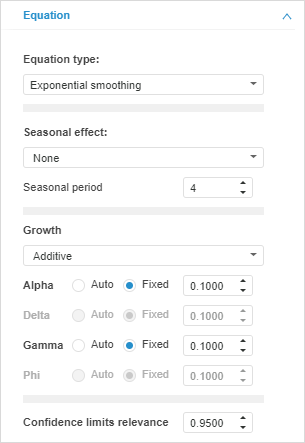 To display the tab
To display the tabExponential smoothing is one of the most popular methods that are used to smooth and forecast a wide range of time series. The method is based on calculating exponential means.
NOTE. In the Exponential Smoothing method, the input variable also serves as the output variable. To create an equation, set the variable binding to itself.
To set up method parameters, use the Equation side panel tab.

Method parameters:
Seasonal Effect. The seasonal component is estimated when the source series demonstrates quite constant repetitive deviations from the average value of a series with a known period, and the series mean varies with time. To reflect the seasonality the model uses the Delta coefficient.
A time series is decomposed into a systematic component (d) and a random component (e). Specify the required seasonality model:
None. It is used by default.
Additive: ŷ = d + e.
Multiplicative: ŷ = de.
Seasonal Period. If a seasonal effect is selected, set the seasonal period length. The default value is 4.
TIP. Minimum number of series observations must satisfy the inequality: Number of observations >= (Seasonal period * 2 + 1).
Growth. Time series often tend to somewhat increase or decrease. In this case the exponential smoothing model uses the coefficient that takes into account growth - Gamma. Specify growth model:
None. It is used by default.
Additive.
Exponential.
Damped.
Alpha. Delta. Gamma. Phi. Set model coefficients values. The coefficients set depends on the selected growth and seasonal effect parameters.
If the Auto radio button is selected, the coefficient is estimated automatically, otherwise coefficient value is set manually in the corresponding value editor. Parameters of automatic coefficient estimation are set up on the Parameters Autofit tab.
Confidence Limits Relevance. Set the confidence limits relevance level for a forecasting series. Values are obtained from the range (0, 1). The default value is 0.95.
See also:
Working with Equations | The Exponential Smoothing Method | Time Series Analysis: Exponential Smoothing | IModelling.Expsmooth